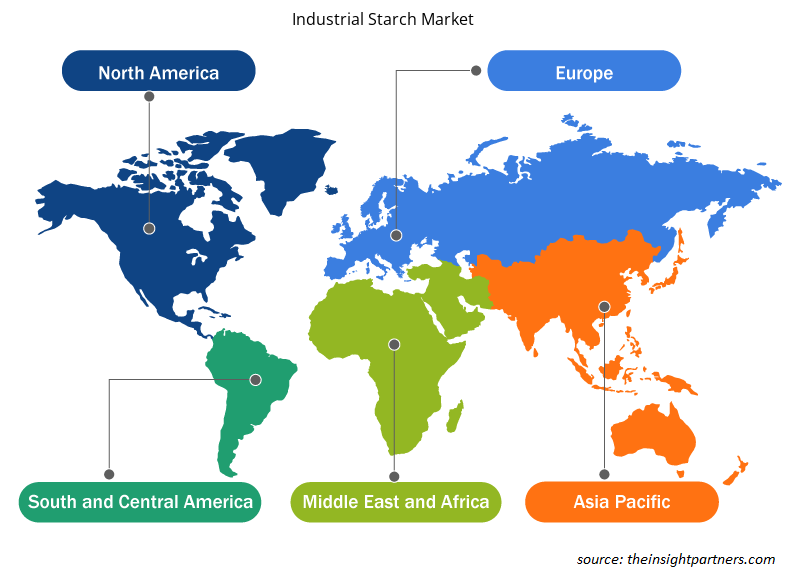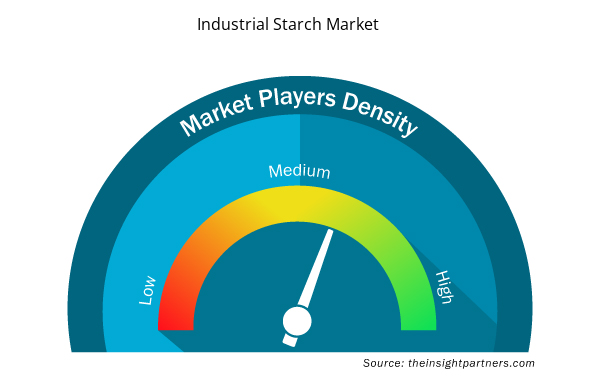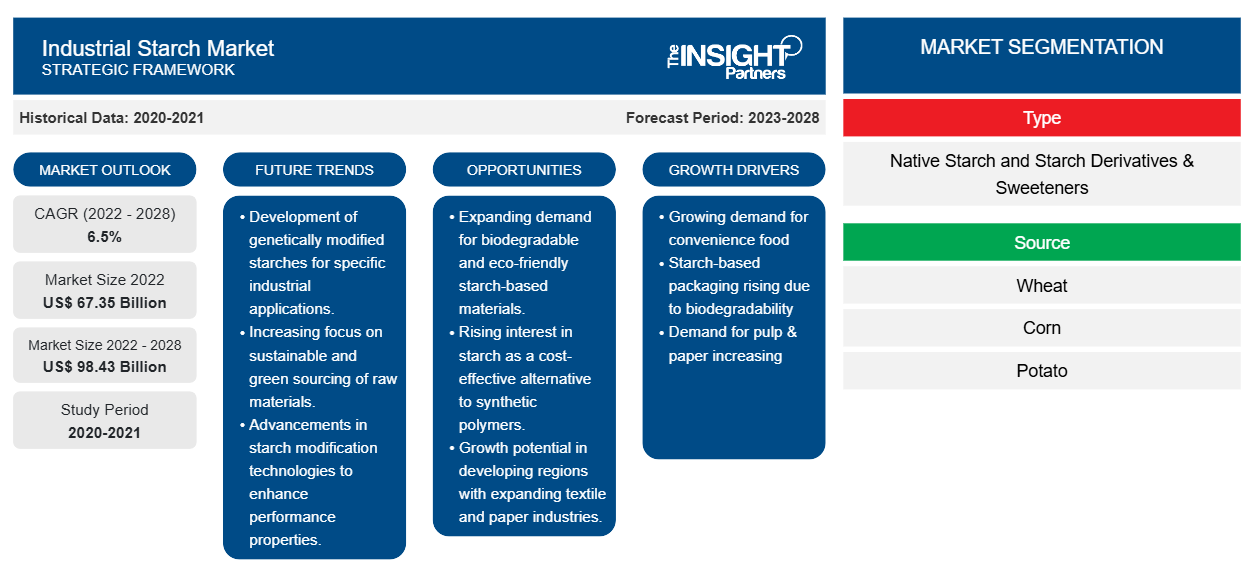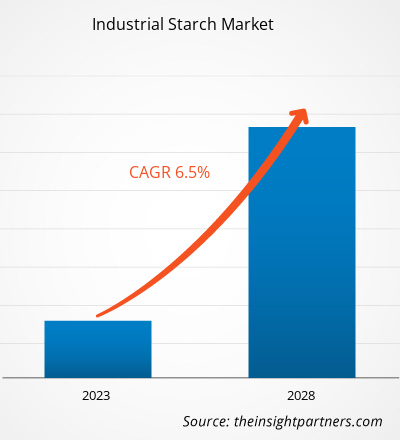[研究报告] 工业淀粉市场预计将从 2022 年的 673.5301 亿美元增长到 2028 年的 984.2674 亿美元;预计 2022 年至 2028 年的复合年增长率为 6.5%。
淀粉是一种复合碳水化合物,来源于小麦、玉米、土豆、木薯和大米。它是一种很好的能量来源。淀粉是各种食品和饮料的增稠剂/胶凝剂和稳定剂,包括烘焙和糖果产品、汤、酱汁、冷冻甜点、奶精和即饮饮料。由于消费者忙碌的生活方式和高人均收入,全球对方便食品的需求正在增加。此外,纸质食品包装需要涂层,以防止水或氧气渗透到包装中并破坏内部食品。通常,这种保护涂层由石油基塑料制成。然而,随着人们越来越意识到石油基塑料对环境的负面影响,制造商正在采用生物基和环保原材料作为纸质食品包装涂层。淀粉基包装的可生物降解性和价格实惠等特性正在推动制造商的普及。
过去几年,随着纸浆和造纸行业规模的扩大,该行业对淀粉的需求大幅增长。蓬勃发展的电子商务行业对瓦楞纸板的需求贡献巨大。此外,为确保环境可持续性而显著转向无塑料包装,推动了对可持续包装材料的需求。根据 Roquette Frères 的研究,由于 COVID-19 疫情期间电子商务行业的大幅增长,2020 年瓦楞纸板制造中工业淀粉的消耗量增长了 6%。因此,纸和纸板行业对淀粉的需求激增,正在提振工业淀粉市场
定制此报告以满足您的需求
您可以免费定制任何报告,包括本报告的部分内容、国家级分析、Excel 数据包,以及为初创企业和大学提供优惠和折扣
- 获取此报告的关键市场趋势。这个免费样品将包括数据分析,从市场趋势到估计和预测。
电子商务行业的增长使世界各地的制造商受益匪浅。在全球范围内,各种制造商和电子商务渠道都在推广使用可持续和环保的包装材料。随着电子商务行业越来越多地采用可持续包装材料,工业淀粉市场的增长预计将得到推动。印度电子商务公司 Myntra 和 Flipkart 已采取减少或消除包装材料中一次性塑料的使用。此外,政府减少塑料污染的政策预计将刺激对工业淀粉的需求。
市场洞察
工业淀粉应用范围广泛推动市场增长
近年来,工业淀粉在各种终端行业中的应用范围不断扩大。它被用作各种食品和饮料的增稠剂、胶凝剂和粘合剂,包括烘焙食品、汤和沙拉酱、糖果、酱汁、冰淇淋、果汁饮料和乳制品。淀粉还用于非食品应用,如纸浆和造纸、药品和动物饲料。在制药行业,淀粉用作片剂制造中的赋形剂和粘合剂。此外,淀粉基材料是可生物降解食品包装材料的完美解决方案,有助于减少环境污染。
类型洞察
根据类型,工业淀粉市场细分为天然淀粉和淀粉衍生物以及甜味剂。2021 年,淀粉衍生物和甜味剂细分市场占据了市场主导地位。由于可支配收入水平的提高和全球人口的增加,对食品和饮料的需求不断增长,以及淀粉衍生物在食品和饮料行业的使用是工业淀粉市场中淀粉衍生物细分市场最重要的增长动力。
Agrana Beteiligungs-AG、ADM、Ingredion Incorporated、Roquette Frères、Tereos Group、Cargill, Incorporated、Tate & Lyle PLC、Grain Processing Corporation、Royal Cosun 和 AVEBE 是工业淀粉市场的主要参与者。领先的参与者采用多种策略,例如并购和产品发布,以扩大其地理覆盖范围和消费者基础。
报告亮点
- 工业淀粉行业的进步趋势,帮助参与者制定有效的长期战略
- 公司采用的业务增长战略来确保发达市场和发展中市场的增长
- 2021年至2028年全球工业淀粉市场定量分析
- 各行业对工业淀粉的需求估计
- 波特五力分析说明工业淀粉行业买家和供应商的效力
- 了解竞争激烈的市场形势和工业淀粉的需求的最新发展
- 市场趋势和前景以及影响工业淀粉市场增长的因素
- 了解与市场增长相关的商业利益战略,帮助决策过程
- 工业淀粉市场各节点规模
- 市场详细概述和细分以及行业动态
- 各地区工业淀粉市场规模及增长潜力巨大
工业淀粉市场区域洞察
Insight Partners 的分析师已详细解释了预测期内影响工业淀粉市场的区域趋势和因素。本节还讨论了北美、欧洲、亚太地区、中东和非洲以及南美和中美洲的工业淀粉市场细分和地理位置。

- 获取工业淀粉市场的区域具体数据
工业淀粉市场报告范围
| 报告属性 | 细节 |
|---|---|
| 2022 年市场规模 | 673.5亿美元 |
| 2028 年市场规模 | 984.3亿美元 |
| 全球复合年增长率(2022 - 2028) | 6.5% |
| 史料 | 2020-2021 |
| 预测期 | 2023-2028 |
| 涵盖的领域 | 按类型
|
| 覆盖地区和国家 | 北美
|
| 市场领导者和主要公司简介 |
|
工业淀粉市场参与者密度:了解其对业务动态的影响
工业淀粉市场正在快速增长,这得益于终端用户需求的不断增长,而这些需求又源于消费者偏好的不断变化、技术进步以及对产品优势的认识不断提高等因素。随着需求的增加,企业正在扩大其产品范围,进行创新以满足消费者的需求,并利用新兴趋势,从而进一步推动市场增长。
市场参与者密度是指在特定市场或行业内运营的企业或公司的分布情况。它表明在给定市场空间中,相对于其规模或总市场价值,有多少竞争对手(市场参与者)存在。
在工业淀粉市场运营的主要公司有:
- AGRANA 担保公司
- 腺苷二磷酸
- 宜瑞安公司
- 罗盖特兄弟公司
- Tereos 集团
免责声明:上面列出的公司没有按照任何特定顺序排列。

- 了解工业淀粉市场顶级关键参与者概况
“2028 年工业淀粉市场分析”是一项针对化学品和材料行业的专业深入研究,侧重于市场趋势分析。该报告旨在提供市场概述和详细细分。工业淀粉市场根据类型、来源、应用和地理位置进行细分。根据类型,工业淀粉市场细分为天然淀粉和淀粉衍生物和甜味剂。根据来源,市场细分为小麦、玉米、马铃薯、木薯等。根据应用,市场细分为食品和饮料、纸浆和造纸、动物饲料、药品等。根据地理位置,分为五个主要地区:北美、欧洲、亚太、中东和非洲以及南美和中美洲。2021 年,亚太地区占据了工业淀粉市场的主导地位。
- 历史分析(2 年)、基准年、预测(7 年)及复合年增长率
- PEST 和 SWOT 分析
- 市场规模价值/数量 - 全球、区域、国家
- 行业和竞争格局
- Excel 数据集



Report Coverage
Revenue forecast, Company Analysis, Industry landscape, Growth factors, and Trends

Segment Covered
This text is related
to segments covered.

Regional Scope
North America, Europe, Asia Pacific, Middle East & Africa, South & Central America

Country Scope
This text is related
to country scope.
常见问题
Growth in the global food and beverage industry and an increase in demand from the packaging industry are drivers of the industrial starch market. The growing population around the world is increasing the demand for the food and beverages industrial starch market. And the significant growth of e-commerce and increasing adoption of eco-friendly packaging material is expected to propel the demand for industrial starch.
The major players operating in the global industrial starch market is AGRANA Beteiligungs-AG; ADM; Ingredion Incorporated.; Roquette Frères; Tereos Group; Cargill, Incorporated Tate & Lyle PLC; Grain Processing Corporation; Royal Cosun; AVEBE.
In 2021, North America accounted for the highest growth of the global industrial starch market. Starch is used as a thickening/gelling agent and stabilizer in a wide range of food and beverages, including bakery and confectionery products, soups, sauces, frozen desserts, dairy creamers, and ready-to-drink beverages. The rising demand for convenience food owing to the hectic lifestyle and high per-capita income of consumers is driving the demand for starch in the food & beverages industry. Veganism and clean-label trends are surging rapidly across the world.
Product innovation in industrial starches is a recent trend in the global industrial starch market. There is a strong demand for products with organic, clean-label, and plant-based ingredients in Europe owing to rising health and wellness concerns. This clean-label product provides instant viscosity, thereby enabling optimal control of rheological behavior in cake mixes, sauces, or other semiliquid formulations. It can also be used to prepare high-quality savory products, pastries, and fruit-based fillings to provide a premium look and texture.
Based on the application pulp and paper segment is leading the market in 2021. As there is a high demand for starch from the papermaking industry in the region due to the rising demand for paper products from the packaging and transportation industries. The booming e-commerce industry in the region is also generating demand for corrugated paper and paperboards, thereby contributing to the industrial starch market progress
Based on the segment type, starch derivatives and sweeteners were the fastest-growing segment in 2021. Starch derivatives and sweeteners are obtained from the further processing of native starch. Usually, native starch is converted into glucose syrup, which is processed to obtain maltodextrins, isoglucose, polyols, and dextrose
Trends and growth analysis reports related to Food and Beverages : READ MORE..
The List of Companies - Industrial Starch Market
- AGRANA Beteiligungs-AG
- ADM
- Ingredion Incorporated
- Roquette Frères
- Tereos Group
- Cargill, Incorporated.
- Tate & Lyle PLC
- Grain Processing Corporation
- Royal Cosun
- AVEBE
The Insight Partners performs research in 4 major stages: Data Collection & Secondary Research, Primary Research, Data Analysis and Data Triangulation & Final Review.
- Data Collection and Secondary Research:
As a market research and consulting firm operating from a decade, we have published and advised several client across the globe. First step for any study will start with an assessment of currently available data and insights from existing reports. Further, historical and current market information is collected from Investor Presentations, Annual Reports, SEC Filings, etc., and other information related to company’s performance and market positioning are gathered from Paid Databases (Factiva, Hoovers, and Reuters) and various other publications available in public domain.
Several associations trade associates, technical forums, institutes, societies and organization are accessed to gain technical as well as market related insights through their publications such as research papers, blogs and press releases related to the studies are referred to get cues about the market. Further, white papers, journals, magazines, and other news articles published in last 3 years are scrutinized and analyzed to understand the current market trends.
- Primary Research:
The primarily interview analysis comprise of data obtained from industry participants interview and answers to survey questions gathered by in-house primary team.
For primary research, interviews are conducted with industry experts/CEOs/Marketing Managers/VPs/Subject Matter Experts from both demand and supply side to get a 360-degree view of the market. The primary team conducts several interviews based on the complexity of the markets to understand the various market trends and dynamics which makes research more credible and precise.
A typical research interview fulfils the following functions:
- Provides first-hand information on the market size, market trends, growth trends, competitive landscape, and outlook
- Validates and strengthens in-house secondary research findings
- Develops the analysis team’s expertise and market understanding
Primary research involves email interactions and telephone interviews for each market, category, segment, and sub-segment across geographies. The participants who typically take part in such a process include, but are not limited to:
- Industry participants: VPs, business development managers, market intelligence managers and national sales managers
- Outside experts: Valuation experts, research analysts and key opinion leaders specializing in the electronics and semiconductor industry.
Below is the breakup of our primary respondents by company, designation, and region:

Once we receive the confirmation from primary research sources or primary respondents, we finalize the base year market estimation and forecast the data as per the macroeconomic and microeconomic factors assessed during data collection.
- Data Analysis:
Once data is validated through both secondary as well as primary respondents, we finalize the market estimations by hypothesis formulation and factor analysis at regional and country level.
- Macro-Economic Factor Analysis:
We analyse macroeconomic indicators such the gross domestic product (GDP), increase in the demand for goods and services across industries, technological advancement, regional economic growth, governmental policies, the influence of COVID-19, PEST analysis, and other aspects. This analysis aids in setting benchmarks for various nations/regions and approximating market splits. Additionally, the general trend of the aforementioned components aid in determining the market's development possibilities.
- Country Level Data:
Various factors that are especially aligned to the country are taken into account to determine the market size for a certain area and country, including the presence of vendors, such as headquarters and offices, the country's GDP, demand patterns, and industry growth. To comprehend the market dynamics for the nation, a number of growth variables, inhibitors, application areas, and current market trends are researched. The aforementioned elements aid in determining the country's overall market's growth potential.
- Company Profile:
The “Table of Contents” is formulated by listing and analyzing more than 25 - 30 companies operating in the market ecosystem across geographies. However, we profile only 10 companies as a standard practice in our syndicate reports. These 10 companies comprise leading, emerging, and regional players. Nonetheless, our analysis is not restricted to the 10 listed companies, we also analyze other companies present in the market to develop a holistic view and understand the prevailing trends. The “Company Profiles” section in the report covers key facts, business description, products & services, financial information, SWOT analysis, and key developments. The financial information presented is extracted from the annual reports and official documents of the publicly listed companies. Upon collecting the information for the sections of respective companies, we verify them via various primary sources and then compile the data in respective company profiles. The company level information helps us in deriving the base number as well as in forecasting the market size.
- Developing Base Number:
Aggregation of sales statistics (2020-2022) and macro-economic factor, and other secondary and primary research insights are utilized to arrive at base number and related market shares for 2022. The data gaps are identified in this step and relevant market data is analyzed, collected from paid primary interviews or databases. On finalizing the base year market size, forecasts are developed on the basis of macro-economic, industry and market growth factors and company level analysis.
- Data Triangulation and Final Review:
The market findings and base year market size calculations are validated from supply as well as demand side. Demand side validations are based on macro-economic factor analysis and benchmarks for respective regions and countries. In case of supply side validations, revenues of major companies are estimated (in case not available) based on industry benchmark, approximate number of employees, product portfolio, and primary interviews revenues are gathered. Further revenue from target product/service segment is assessed to avoid overshooting of market statistics. In case of heavy deviations between supply and demand side values, all thes steps are repeated to achieve synchronization.
We follow an iterative model, wherein we share our research findings with Subject Matter Experts (SME’s) and Key Opinion Leaders (KOLs) until consensus view of the market is not formulated – this model negates any drastic deviation in the opinions of experts. Only validated and universally acceptable research findings are quoted in our reports.
We have important check points that we use to validate our research findings – which we call – data triangulation, where we validate the information, we generate from secondary sources with primary interviews and then we re-validate with our internal data bases and Subject matter experts. This comprehensive model enables us to deliver high quality, reliable data in shortest possible time.


 获取此报告的免费样本
获取此报告的免费样本